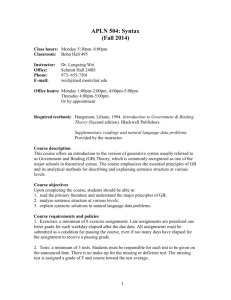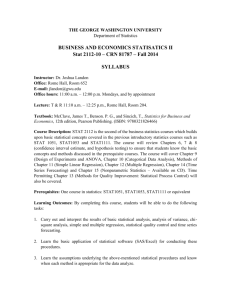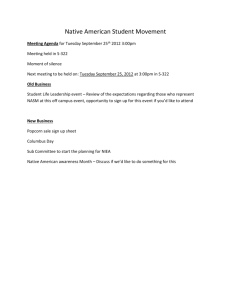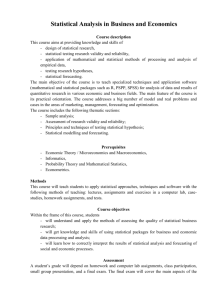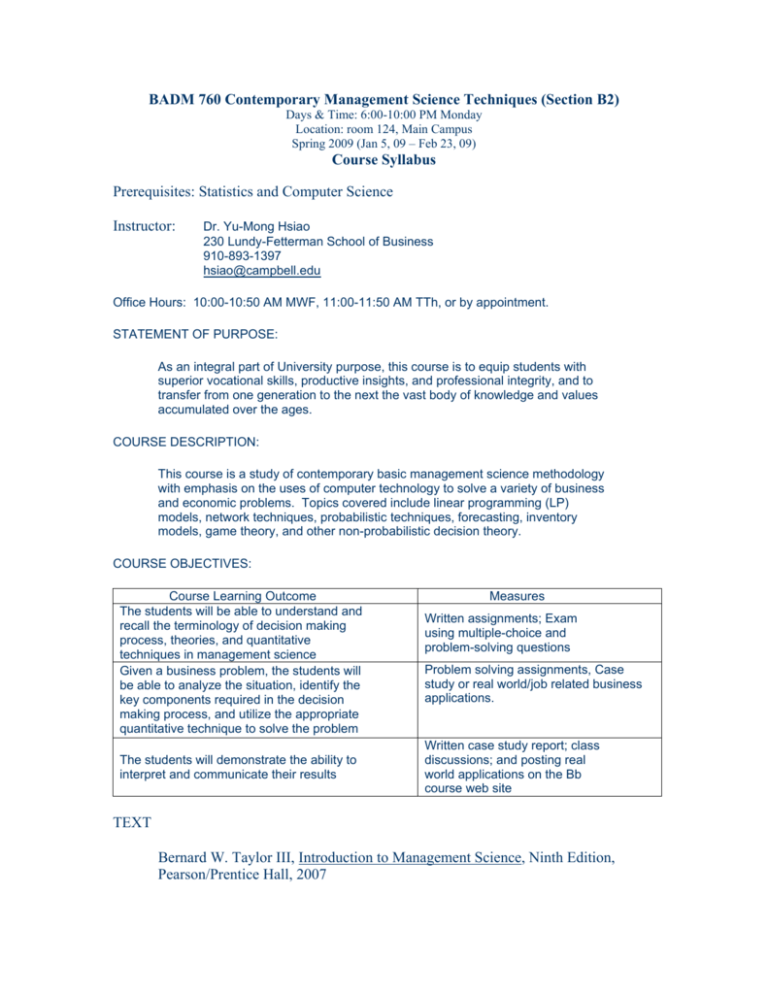
BADM 760 Contemporary Management Science Techniques (Section B2)
Days & Time: 6:00-10:00 PM Monday
Location: room 124, Main Campus
Spring 2009 (Jan 5, 09 – Feb 23, 09)
Course Syllabus
Prerequisites: Statistics and Computer Science
Instructor:
Dr. Yu-Mong Hsiao
230 Lundy-Fetterman School of Business
910-893-1397
hsiao@campbell.edu
Office Hours: 10:00-10:50 AM MWF, 11:00-11:50 AM TTh, or by appointment.
STATEMENT OF PURPOSE:
As an integral part of University purpose, this course is to equip students with
superior vocational skills, productive insights, and professional integrity, and to
transfer from one generation to the next the vast body of knowledge and values
accumulated over the ages.
COURSE DESCRIPTION:
This course is a study of contemporary basic management science methodology
with emphasis on the uses of computer technology to solve a variety of business
and economic problems. Topics covered include linear programming (LP)
models, network techniques, probabilistic techniques, forecasting, inventory
models, game theory, and other non-probabilistic decision theory.
COURSE OBJECTIVES:
Course Learning Outcome
The students will be able to understand and
recall the terminology of decision making
process, theories, and quantitative
techniques in management science
Given a business problem, the students will
be able to analyze the situation, identify the
key components required in the decision
making process, and utilize the appropriate
quantitative technique to solve the problem
The students will demonstrate the ability to
interpret and communicate their results
Measures
Written assignments; Exam
using multiple-choice and
problem-solving questions
Problem solving assignments, Case
study or real world/job related business
applications.
Written case study report; class
discussions; and posting real
world applications on the Bb
course web site
TEXT
Bernard W. Taylor III, Introduction to Management Science, Ninth Edition,
Pearson/Prentice Hall, 2007
SOFTWARE & WEB RESOURCE:
1. Excel QM, Crystal Ball, TreePlan, The Management Scientist, V.6 (packed with UG
textbook)
2. Text Web Page: www.prenhall.com/taylor
SUPPLEMENTARY READINGS AND REFERENCES:
1. William J. Stevenson & Ceyhun Ozgur, Introduction to Management Science with
Spreadsheets, McGraw-Hill/Irwin, 2007
2. Winston Albright, Practical Management Science, 3e, Thomson/South-Western, 2007.
3. Anderson, Sweeney & Williams, Quantitative Methods for Business, 10th Edition, SouthWestern/Thomson Learning, 2006
SUPPORT SERVICES:
1. Students with documented disabilities who desire modifications or accommodations
should contact the office of Student Support Services located in the University's Hight
House.
2. For disability and tutoring services, contact: Miss Laura Rich - Director of Student
Support Services, Hight House 104, 910-814-4364
3. For personality and career interest testing, and job placement services, contact: Mr.
John Creech - Assistant Dean of Student Services, Hight House 103, 910-893-1901 or
creech@campbell.edu
ATTENDANCE REQUIREMENT:
1. Students are expected to be punctual and to comply with the University’s class
attendance policy described on page 21 of Campbell University Bulletin; 2007-2009.
2. Students who fail to attend at least 85 percent of the class meetings (which means five
absences or more) will not receive credit for this course. Each student should keep a
record of his/her absences to avoid over-cutting.
3. If a student arrives after the roll has been called, the student will be counted absent
unless he/she informs the instructor of his/her arrival immediately after class. Threetardiness will count as one absence. Early departure without permission and tardy for
more than15 minutes will count as an absence.
IN-CLASS USE OF LAPTOPS AND SIMILAR ELECTRONIC DEVICES
In-class use of laptops, PDAs, cell phones, and other similar electronic devices is
not permitted unless it is pre-approved or specifically instructed by the
instructor.
GRADING SYSTEM*:
1.
2.
Two major tests
Case Studies (10%), Discussion Board applications,
Quizzes and homework (10%)
Total
80%
20%
100%
*Notes:
1. Tentative Test Dates:
Mid-term Test
Final Exam
January 26, 6:00pm - 8:00pm
February 23, 8:00pm - 10:00pm
2. No make-up quiz will be given for any reasons (excused or not). A zero
grade will be assigned to the missing quiz. Homework assignments,
delivery methods and due dates will be posted on the course website.
Assignments, including case studies, discussion board posts, and
homework, will not be accepted after the deadline.
3. All tests are mandatory. Missing either the mid-term or final exam will
result in failing the course. If you know in advance that you will not be
able to take the test on the date scheduled, the test should be taken
early with instructor approval. If you miss a test with valid unexpected
reasons, you are responsible for contacting the instructor ASAP to take
the make-up test before the next class. Students who fail to take the
make-up test during the permissible period will receive a zero grade.
4. Honor Code: Cheating of any kind including plagiarism will not be
tolerated. The Honor Code applies to the major tests, pop quizzes,
homework, case studies and all course assignments. Any cheating will
result in an FX as the course grade and other possible sanctions.
5. There is approximately one quiz on each topic.
6. Due date, format, delivery method, and other detailed information
concerning case studies, discussion board application, quizzes and
homework assignment will be discussed in the first class.
7. Grading Scale: A = 90 and above; B = 80s; C = 70s and F = below 70.
Students earn their grade according to the grading system indicated in
this syllabus. To be fair to all students, I do not allow any individual to do
extra project or work to improve his/her grade. I do not curve test grade,
but I will make minor adjustment for the final letter grade if a student’s
overall average is less than half of a point away from the next better
grade.
COURSE OUTLINE:
Part 1. Introduction and Math Review (Ch. 1)
Quantitative Methods in Practice
Part 2. Linear Programming (Ch. 2, 3, 4)
LP Formulation and Graphical Solution (Ch.2)
Computer Solution and Sensitivity Analysis (Ch.3)
LP Modeling Examples (Ch.4)
Part 3. Transportation, Transshipment, and Assignment Problems (Ch. 6)
LP formulation & Computer Solution
Part 4. Network Flow Models (Ch. 7)
Part 5. Project Management (Ch. 8)
PERT network
The Critical Path
PERT under Uncertainty
The LP Formulation for Project Crashing Decision
Part 6. Decision Theory (Ch. 12)
Decision making under uncertainty
Deterministic Decision Criteria
Optimistic approach (maximax, Minimin)
Conservative approach (Maximin, minimax regret)
Probabilistic Decision Criteria
Expected Value criterion
Maximum Likelihood Principles
EVPI
Decision Tree Analysis
Expected Utility and Game Theory (CD-ROM Module E)
Part 7. Forecasting & Regression Analysis (Ch. 15)
Forecasting Methods
• Time Series Methods
• Moving Average
• Weighted Moving Average
• Exponential Smoothing
• Linear Trend Projection
• Seasonal Adjustments (handout)
o Forecasting Accuracy Criteria: MAD, MSE
Regression Analysis
• Simple linear regression
• Multiple linear regression
o Goodness of fit (R2 and F test)
Part 8. Inventory Management (Ch. 16)
The simple EOQ model
The EOQ model with noninstantaneous receipt
The EOQ model with shortages
The EOQ model with quantity discounts
The Reorder Point and Safety Stocks
Part 9. Probabilistic Techniques
Queuing Analysis (Ch. 13)
Markov Process Models (CD-ROM Module F)
Tentative Schedule:
January 5
12
19
26
February 2
Syllabus, Introduction to LP (Ch. 2), Computer solution and
Sensitivity Analysis (Ch.3)
LP Modeling (Ch. 4),
Transportation/Transshipment/Assignment problems (Ch. 6)
Network Flow Models (Ch. 7)
Network Flow Models (Ch. 7), PERT/CPM (Ch. 8)
6:00PM -8:00PM: Mid-term Test (Ch. 2, 3, 4, 6, 7, 8)
8:15PM - 10:00PM: Decision Theory (Ch.12)
Decision Theory (Ch.12), Forecasting & Regression Analysis
(Ch.15)
9
16
23
Forecasting/Regression Analysis (Ch. 15), Inventory
Management (Ch. 16)
Inventory Management (Ch. 16), Queuing Analysis (Ch. 13);
Markov Process Models (CD-ROM Module F)
Case Study/Presentation (to be determined in the first class);
Final Exam




